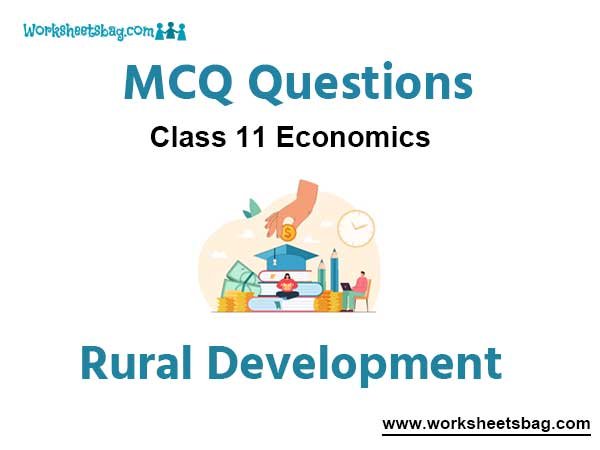Please refer to MCQ Questions Chapter 6 Rural Development Class 11 Economics with answers provided below. These multiple-choice questions have been developed based on the latest NCERT book for class 11 Economics issued for the current academic year. We have provided MCQ Questions for Class 11 Economics for all chapters on our website. Students should learn the objective based questions for Chapter 6 Rural Development in Class 11 Economics provided below to get more marks in exams.
Chapter 6 Rural Development MCQ Questions
Please refer to the following Chapter 6 Rural Development MCQ Questions Class 11 Economics with solutions for all important topics in the chapter.
MCQ Questions Answers for Chapter 6 Rural Development Class 11 Economics
Question. Which status has been accorded to the retail chains and supermarkets for selling organic food?
(A) Eco Status
(B) Sustainable Status
(C) Nutritional Status
(D) Green Status
Answer
D
Question. What was the growth rate of agricultural output during 2007-12?
(A) 1.5% per annum
(B) 6% per annum
(C) 32% per annum
(D) 5% per annum
Answer
C
Question. Which source of credit had emerged to fully integrate the formal credit system into the overall rural social and community development?
(A) Self-help Groups
(B) Regional Rural Banks
(C) Commercial Banks
(D) Land Development Banks
Answer
A
Question. Which status has been accorded to the retail chains and supermarkets for selling organic food?
(A) Eco Status
(B) Sustainable Status
(C) Green Status
(D) Nutritional Status
Answer
C
Question. Lingering Challenges include :
(A) Challenge of rural credit
(B) Challenge of rural marketing
(C) Challenge of Unemployment
(D) Both a and b
Answer
D
Question. Arrange the marketing process in order
(1) Grading the produce as per quality
(2) Gathering the produce after harvesting
(3) Processing the produce
(4) Packing the produce
(A) 1,2,3,4
(B) 2,3,1,4
(C) 1,3,2,4
(D) 3,1,2,4
Answer
B
Question. ____ is an important source of occupation for the women.
(A) Fishing
(B) Agriculture
(C) Livestock Farming
(D) Horticulture
Answer
C
Question. Non-institutional source of rural credit includes
(A) Money lenders
(B) Commercial banks
(C) Regional Rural banks
(D) None of these
Answer
A
Question. Which Indian state has been held as a success story in the efficient implementation of milk cooperatives?
(A) Punjab
(B) Gujarat
(C) Uttar Pradesh
(D) West Bengal
Answer
B
Question. The scheme of microfinance is extended through
(A) Self-help Groups
(B) Land Development Banks
(C) NABARD
(D) Regional Rural Banks
Answer
A
Question. Rural credit is required for farming because
(A) Most farming families have small landholdings.
(B) They produce only for self-consumption
(C) They need funds for further investment in agriculture
(D) All of these
Answer
D
Question. Which of the following is an institutional source of rural credit?
(A) Moneylenders
(B) Regional Rural Banks
(C) Traders
(D) Landlords
Answer
B
Question. The duration of medium-term credit is
(A) 12 months to 5 years
(B) 2 to 5 years
(C) 5 to 20 years
(D) 6 to 12 months
Answer
A
Question. The apex funding agency for providing rural credit is
(A) Regional Rural Bank
(B) NABARD
(C) SBI
(D) None of these
Answer
B
Question. Which among the following is an initiative taken for the development of rural India?
(A) Human Capital Formation
(B) Land Reforms
(C) Poverty Alleviation
(D) All of these
Answer
D
Question. _____ is an initiative taken up by the government to improve marketing system.
(A) Intermediaries
(B) Whole sale markets
(C) Regulated Market
(D) None of these
Answer
C



